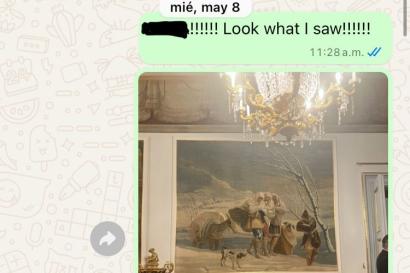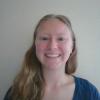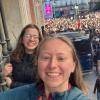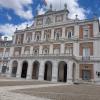We were standing awkwardly in a group outside the metro station, waiting for Spanish university students to come and show us around a city in which we were still taking baby steps on wobbly foreign legs, when my classmate mentioned the Madrid marathon happening at the end of April. He was training for it, he told us, and we should too – it would be fun!
I knew instantly that I wasn’t going to run a marathon. Training for a 26-mile race demands a lot of time, and I wasn’t sure that I wanted to plan my one semester in Spain around a running schedule. But when my newly-made friend googled the race, she found that it also included some shorter distances, like a 10-kilometer run through the heart of the city the weekend before we’d leave.
I had never done a race that long before. My one season of high school cross-country didn’t come close; such a distance boggled my mind when my classmate mentioned his marathon. I wasn’t sure I could even comfortably run three miles, let alone the 6.3 miles that make up a 10k.
But it was January; we’d been in Madrid for one week out of four months, and the end seemed impossibly far away. It was hard to conceptualize the fact of our existence in April, inconceivable to look so far into the future; and it did feel like the distant, untouchable future then, even though looking back it all feels like one single “present,” one amalgamated rush of joy and purpose. From January to May? It felt like an eternity. And we could do anything, everything we’d ever wanted, in an eternity, right?
So we signed up for the 10k.
We signed up for the 10k, and then we had to do something about it. We glanced at each other and laughed; neither of us had a running coach or that much knowledge. But, we decided, we were going to at least try. We were going to put some effort in, and we were going to train for this race.
There were some puzzles to solve. First there was the matter of when I would run. I’m a morning-run fan; at college, with a dining hall open for hours at a time, this isn’t an issue. But I lived (oh, the ache of that past tense) in Spain with a host family, whose two parents and four children all convened around the table during an approximately fifteen-minute window before they all rushed off to school or work. I needed to be back by then if I wanted to eat – or, at least, if I wanted to eat surrounded by laughter, arbitrating debates about olive oil pitchers and getting my host siblings’ advice on the best kind of ham. After much hemming and hawing and attempts at evening runs, I figured out when I needed to set my alarm to be back in time for breakfast, and I knew to start sprinting if I was still on the street when the churchbells chimed.
Then there was the question of where to run. At first, I played it safe, sticking to a simple out-and-back route in my neighborhood. It was about two and a half miles following one long road, and even though that route was eventually so simple that it became my easy run on “rest days,” it was a part of my training cycle just as much as the seven-milers –thousands of footfalls against pavement that made me strong enough for thousands more.
Eventually, though, I outgrew that road for my daily runs, and began to seek out longer distances. I found a map of the neighborhood on a streetcorner near my homestay and plotted out a new, longer route. I ran with my metro card in my pocket, a safety net because I was not yet confident that I wouldn’t accidentally end up on the wrong side of the city.
One day, I would go into the Museum of the History of Madrid, look at maps of the city showing its slow growth over 500 years, and be able to tell my friend with a single glance, “Hey, the city developed my running route by 1875!” But in February I ran with Google Maps open on my phone, pulling it out of my pocket every few blocks to check my turns. I repeatedly got lost in traffic circles; I confused streets and landmarks. Every few days, though, I’d figure it out a little bit better – I’d remember a particular store that marked a turn or figure out the difference between two confusingly-similar fountains. I learned which metro station meant I was almost home and which turn emptied me out onto a 1.5-mile straight-uphill stretch that would be the grittiest, sweatiest part of the route.
And slowly but surely, I learned to run.
This semester, I ran in Madrid. I ran in Granada; I ran in Cordoba; I ran in Valencia and Vienna and Copenhagen. And I grew. By March I had been to several restaurants I’d discovered just by running past them; by April I knew which streets I could dart across against the traffic light (if you’re reading this, Mom, I never did that) and at which intersections I had to obey the street signs. I began to know how to measure my timeliness: I was earlier than average if the café by the Quevedo traffic circle hadn’t yet set out their outdoor seating, later than average if the streetlights switched off before I reached Cuatro Caminos. As my IES Abroad History of Madrid class progressed, I began to realize that my route was a tour of the city’s industrial history; every time I ran past the Calle de Bravo Murillo or the Canal de Isabel II, I refreshed my memory for my midterm and then final exams.
And that particularly brutal 1.5-mile uphill? A few weeks after I started running it consistently, I got an alert from my run-tracking app: it had awarded me a virtual laurel crown, for registering the most efforts on that stretch over the last few months. All the runners in the world and I ran uphill between San Bernando and Cuatro Caminos metro stations more than every single one of them. I screenshotted that notification and posted it on my Instagram, and felt like a real runner now that I was wearing a crown.
On April 28, I ran ten kilometers. I ran ten kilometers in my adopted hometown, through streets I had grown to love, by the side of a girl I had traveled to new cities and countries and continents with. We sung along with the blasted music and waved at all the cameras and recognized landmarks from her architecture class and we ran. In the end, I met my time goal (just barely) and then gorged myself on the free bananas and cookies and chatted (in Spanish) with other runners. In the end, I walked back with a medal decorated with landmarks I’d grown to recognize on my neck, along a stretch of the route that had prepared me for this moment, and I went home to my host family and told them about everything and I couldn’t stop smiling.

It’s a nice ending. The thing is that we don’t really live in a world with endings, where books conclude and then close and there are no more messy pieces we have to juggle in our hands when we have to keep living anyway. The girl I was in Madrid does not get to be herself forever; she has to change and adapt and revert; with all the ways she grew abroad, sometimes it feels like she has to shrink to fit back into her old life, and sometimes it really, really hurts.
The day I flew away from my heart in Madrid, I got a notification from my running app telling me that another runner had stolen my Laurel Crown, and that I should go run that San Bernando-Cuatro Caminos stretch again to earn it back. Exhausted and grieving, this sent me over the edge of tears: how was it fair that other people got to be enjoying the best, most important parts of my life as if it were just another day, when they were so impossibly out of reach for me?
That’s the weird thing about departure: the world doesn’t stop when you leave. On the fourth floor of an elementary school in Puerta del Angel, there are children telling stories about their weekends that I will never hear again, having their daily meditation to a song that will forever transport me back to a classroom adorned with feathers and finger-paint, squabbling over toothpaste in kindergarten disputes that I will never, ever return to mediate (I wonder if they will remember the games I taught them). In the coziest second-floor apartment in Madrid, bursting with love and laughter, a family is rearranging their dining room table to seat six instead of seven and scrubbing my fingerprints off the furniture (I wonder if they will know my name in a year). And a few blocks away, runners are running uphill between San Bernardo and Cuatro Caminos, over and over and over again like nothing has changed, because really, what has; what is one foreign heartbeat to a city the size of Madrid? Someone else has taken that virtual laurel crown and earning it back feels impossible and my heart feels hollow for it.
But just because I won’t ever run there again does not mean that I was not the single runner in the world who ran the most repetitions of that segment in April of 2024; the girl who exhausted her muscles on that godforsaken hill is not unreachable behind me but still somehow inside of me, even though it feels harder to reach her when she speaks a different language and lives with a different family and laughs with different friends. This is the task that I set myself now, whenever I feel confused and alone: I will remember that she is still part of me, that the words she learned remain part of my vocabulary, that the muscles she strengthened are still mine to use. I will learn to carry her with me, that girl who I once was on the hills of Madrid, sprinting and sweating and smiling in the sunrise.


Maple Buescher
Hi!! My name is Maple and I'm a junior at Bates College, where I am a member of the sailing team, the orchestra, and everything in between. I am the Editor in Chief of our student newspaper and am interested in pursuing a journalism career.







